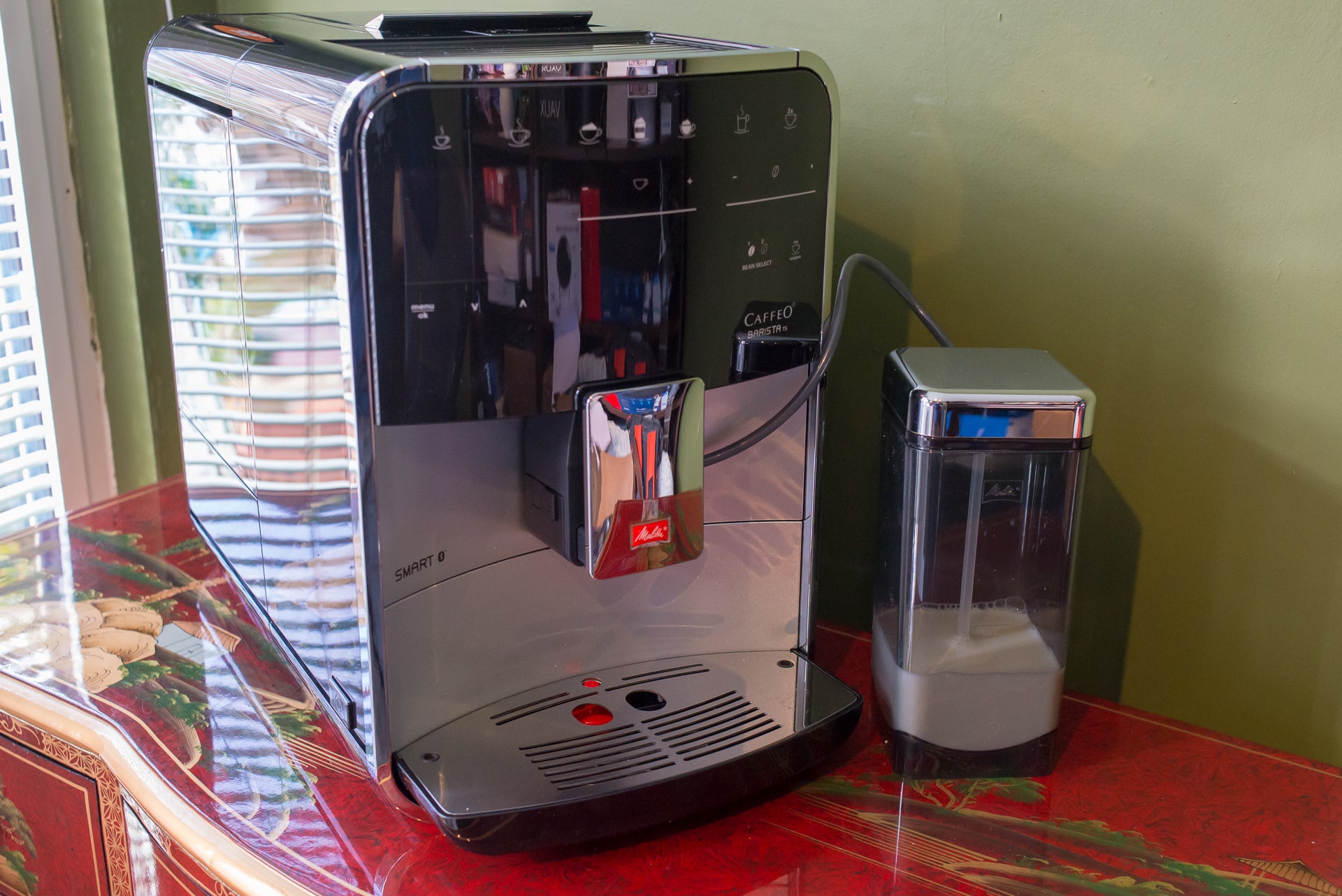There’s nothing quite like coffee: it’s like wine in the choice of varieties with the added bonus that it can be made in numerous different ways from a basic filter machine to a full-on espresso machine. What’s really important is that you get quality coffee each time using the best coffee machine for you.
We’ve reviewed every type of machine (filter, espresso, bean-to-cup and pod) and are bringing you the top choices in one handy list. We take our testing very seriously and even roast our own beans from scratch. For convenience, we’ve listed our top machines in the list below, but you can scroll down to read more about each choice, and even click through to the full review if you want more detail on your final choices.
- Best overall bean-to-cup coffee machine: Melitta Barista TS Smart
- Best budget bean-to-cup machine: Melitta Avanza Series 600
- Best overall manual espresso machine: Sage Barista Pro
- Best standard manual espresso machine: Sage The Bambino Plus
- Best overall pod machine: Sage Nespresso Creatista Uno
- Best pod machine for long drinks: Nespresso Vertuo Next
- Best filter machine overall: Melitta EPOS
- Best filter machine for simplicity: Melitta AromaFresh Grind and Brew
- Best overall coffee accessory: Nespresso Barista
How we choose the best coffee machines
Testing coffee machines is all about getting the best-quality coffee out of them, ensuring that each one can produce the best-tasting cup of the black stuff. It’s a job that we take very seriously, and our testing is dependent on the type of coffee machine that we’re reviewing. For any that use ground coffee or whole beans, we roast our own batch of Peruvian beans. We use a medium roast, a little lighter than you’d probably use at home so that we maintain the beans’ origin flavours.
By controlling the roast and beans used, we can compare the machines that we review, taste-testing each one. We think it’s fair to give each machine a thorough working through, so we adjust the grind and, where required, tamp until we get the best results. All coffee dispensed is tested for temperature (around 65C is right for espresso).
Where milk’s involved, we manually froth where available and use automatic options otherwise. We’ll adjust technique and settings until we’re satisfied that we’re producing the best steamed milk that the coffee maker can deliver. You can read more in our how we test coffee machines article.
Melitta Barista TS Smart
Our favourite bean-to-cup coffee machine
The Melitta Barista TS Smart is a top bean-to-cup coffee machine, capable of producing high-quality drinks – from spot-on espresso to enticing cappuccinos and lattes – all at the touch of a button. This machine has 10 user profiles, so everyone in your house can customise their favourite recipes. The “smart” part of the name refers to the Bluetooth app, which makes it easy to program your favourite drinks using your phone.
This machine has dual bean hoppers on top, so you can have different varieties for different drinks, or give two people in your home their favourite beans. This is a feature that we’ve only seen replicated on much more expensive machines.
What’s really important is that this coffee machine can produce excellent espresso that’s pretty much as good as you can get from a manual espresso machine. And, it’s rather good at steaming milk, too, producing excellent cappuccinos and lattes. If you want a huge variety of drinks but you don’t really want to have to do the job yourself, this is the bean-to-cup machine for you.
Coffee machine type: Bean-to-cup, Size: 372 x 259 x 467mm, Milk frothing: Yes (automatic), Water tank size: 1.8-litres
Read our full Melitta Caffeo Barista TS Smart review
Melitta Avanza Series 600
An excellent-value bean-to-cup machine
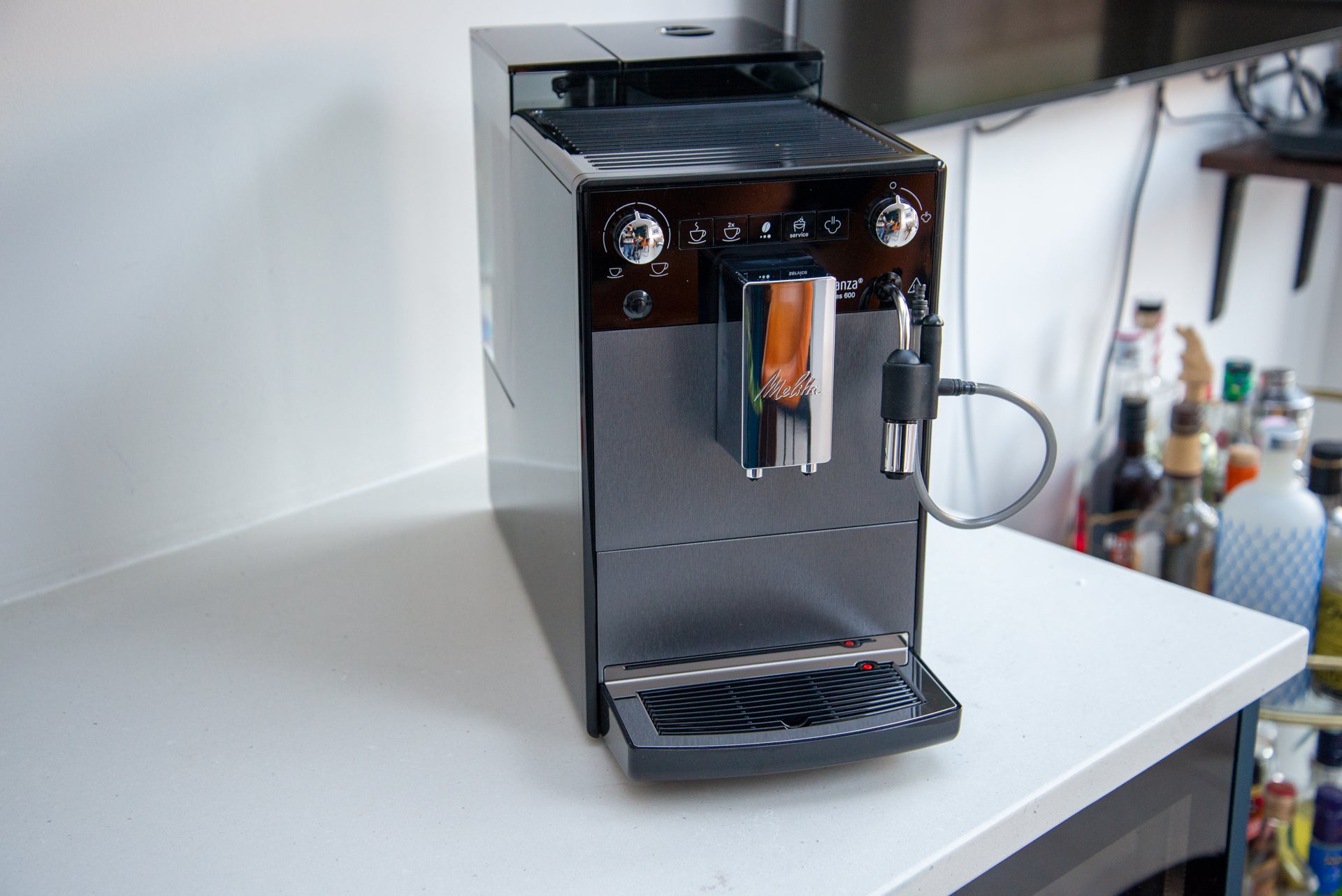
Although bean-to-cup machines can be hugely expensive, the Melitta Avanza Series 600 bucks the trend, and is one of the cheapest machines that can also automatically froth milk.
There’s a single bean hopper on top, and simple buttons on the front to select the type of drink that you want (or even two if you want to make two drinks or a double espresso). Espresso quality is excellent, with a thick and rich crema, and a decent shot of the black stuff all with very little effort.
For milk, you can just dunk the provided house into a bottle or jug, and the Series 600 will do the job of steaming milk automatically. Results aren’t perfect and there’s little control over the final result, so all drinks tend to come out with a similar head of milk, rather than, say, a frothier head for cappuccino and a finer texture for a flat white. If you like your fancier milk drinks, a manual machine or a more expensive bean-to-cup machine may make more sense, but the Avanza Series 600 is great for espresso lovers and more occasional milk use.
Coffee machine type: Bean-to-cup, Size: 353 x 200 x 455mm, Milk frothing: Yes (automatic), Water tank size: 1.5-litres
Read our full Melitta Avanza Series 600 review
Sage Barista Pro
Our favourite manual espresso machine

If you want the best quality coffee that you can get, a manual machine is the way to go, and the Sage Barista Pro is about as good as you can get. This model has a built-in coffee grinder, perfectly designed to work with the coffee machine. While you will need to adjust the grind for each type of bean, this integration makes the job easier. Well, once you get your head around the slightly confusing grinder settings that is.
Properly set up, this machine can deliver a shot of espresso up there with one from your favourite coffee shop: a rich crema, smooth shot and all of the subtle flavour that you’d want. It takes a little time to get there, learning how to tamp the right amount and dosing the correct coffee, but the journey is worth it.
There’s a manual steamer wand, which delivers steam at the right flow rate to get perfectly textured milk. Again, it takes time and practice, but learn the technique and you’ll have any type of drink that you want.
If you like the idea of a manual espresso machine, the Sage Barista Pro is an excellent choice: you still have to practice to get the best results, but everything you need is in one (large) package.
Coffee machine type: Manual espresso, Size: 354 x 410 x 406mm, Milk frothing: Yes (steam wand), Water tank size: 2-litres
Read our full Sage Barista Pro review
Sage The Bambino Plus
An excellent, small manual espresso machine
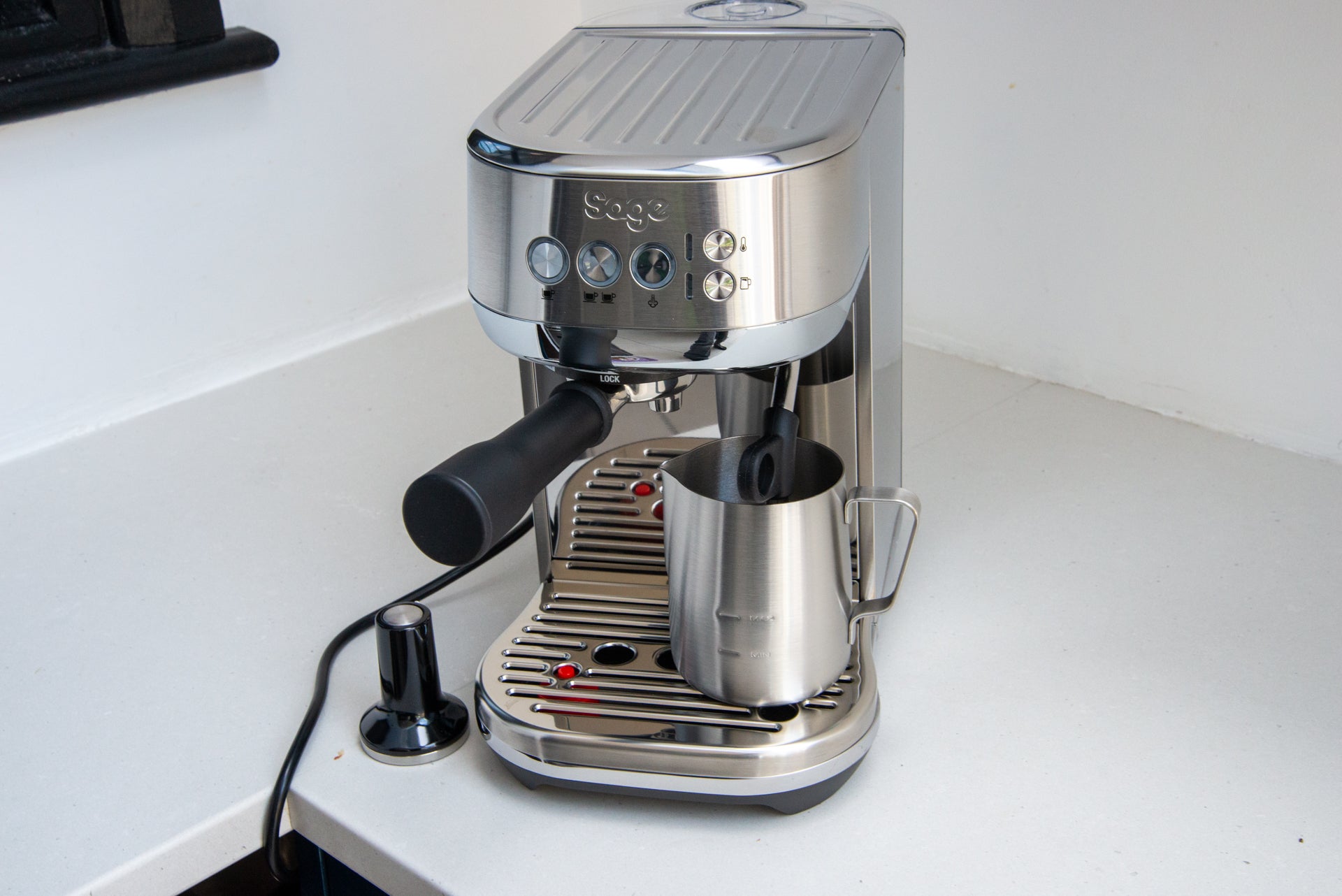
If you don’t have much counter space and want a manual espresso machine, the Sage The Bambino Plus is an excellent choice. This relatively compact machine is extremely well made and can still deliver an excellent shot of coffee.
This model doesn’t have a coffee grinder, so you’ll need to buy a burr grinder that can grind espresso for you. Sage ships this machine with single- and double-walled filters (the former is for high-quality grinders, the latter is more forgiving of a coarser grind from a cheaper grinder). That means you’ll need to experiment a little get the right results.
It’s worth persevering as you can get an almost-perfect shot of espresso: a smooth and oily crema, with a dark shot of coffee underneath. Taste is, perhaps, a little off from the pro-end of the market, but we’re talking subtle differences here.
Steaming milk is an art form unto itself, so it’s nice to see that you can use the Bambino in automatic mode, steaming directly into the jug, or you can pull the wand out and do the job yourself. This gives you options and lets you get steamed milk the easy way until you practice enough to do the job manually. If you want a compact espresso machine and still want good results, this is the machine to buy.
Coffee machine type: Espresso, Size: 195 x 320 x 310mm, Milk frothing: Yes (automatic or manual), Water tank size: 1.9-litres
Read our full Sage The Bambino Plus review
Sage Nespresso Creatista Uno
Our favourite pod espresso machine
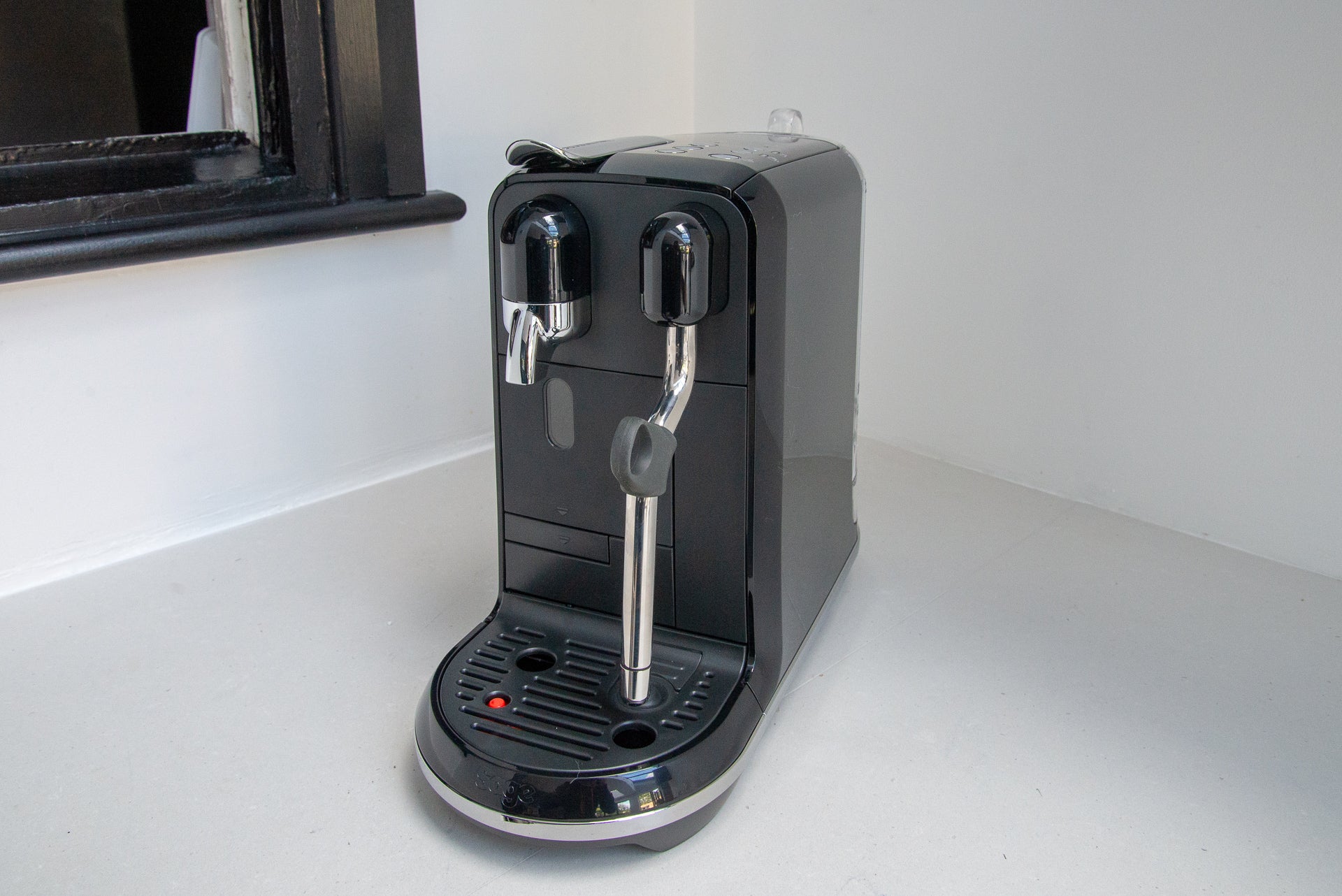
Pod machines are built for ease, not necessarily artistic ability. The Sage Nespresso Creatista Uno changes that, with a machine that gives you the ease that you’d expect from a pod machine, but the ability to free-pour milk to make your own creations like a professional barista. Taking a standard milk jug, the Creatista Uno can steam milk automatically; the pouring is up to you.
High-quality espresso comes at the touch of the button, with this model supporting Nespresso’s ristretto, espresso and lungo settings. Best of all, the coffee machine is excellent value and won’t take up much room on your worktop.
Coffee machine type: Pod (Nespresso), Size: 410 x 170 x 310 mm, Milk frothing: Yes (automatic steamer wand), Water tank size: 1.5-litre
Read our full Sage Nespresso Creatista Uno review
Nespresso Vertuo Next
Our favourite pod machine for long drinks
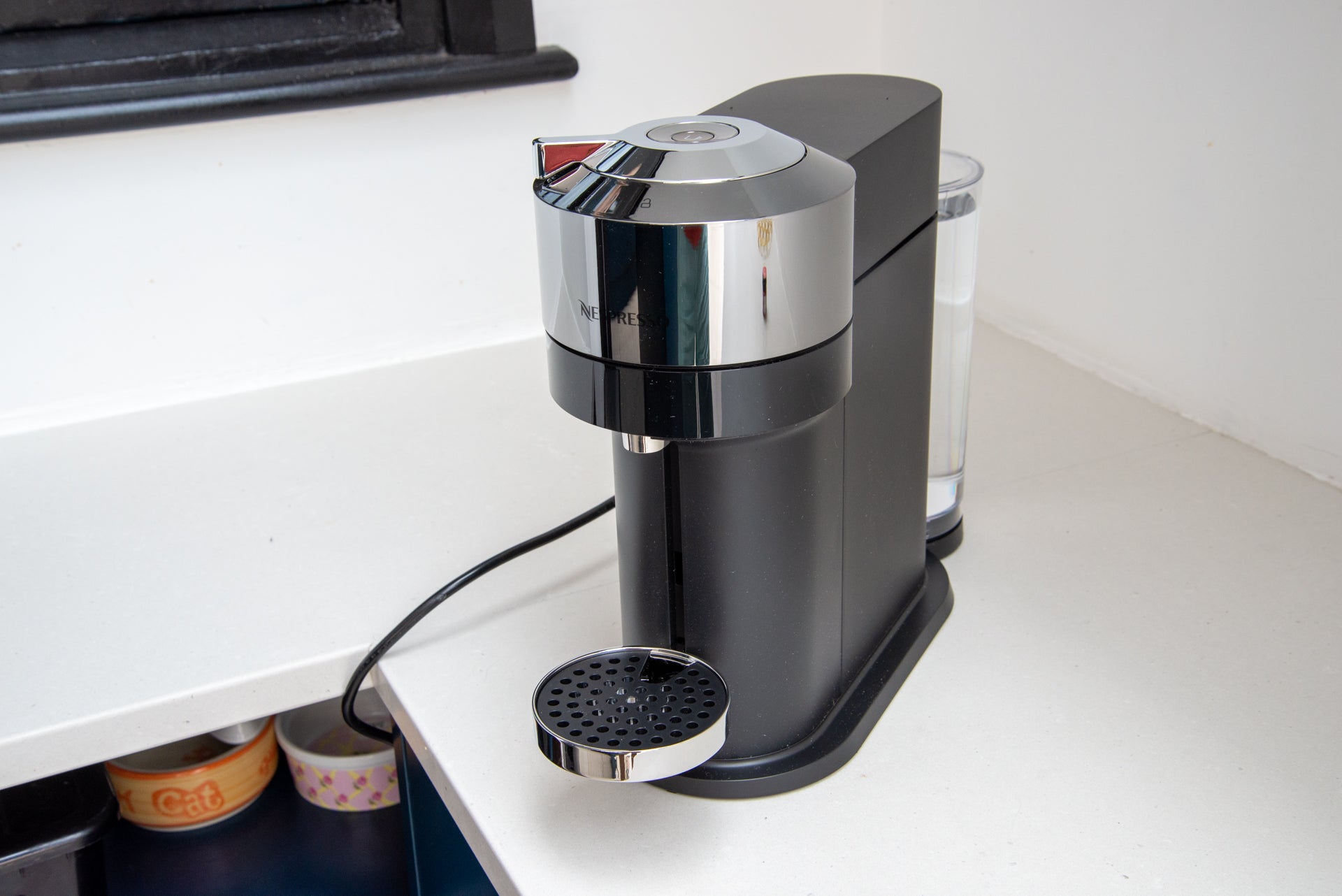
The Nespresso Vertuo system uses larger capsules capable of delivering a longer drink of coffee, right up to a mug full. The first machine was excellent, and now the Nespresso Vertuo Next refines the system. This new coffee machine is neater looking and better built, although you lose the old motorised lid and now have a manual lock instead: make sure it’s properly locked shut or the machine won’t work.
There’s a single button to operate: tap this and the barcode on the coffee pod is read to deliver the right volume of coffee (from 40ml espresso up to 440ml, although 230ml is the most common). There’s a huge choice of Vertuo pods to choose from, including single-origin coffee and flavoured ones.
Nespresso uses a centrifugal brewing system that creates a luxurious and thick crema, with a smooth drink of coffee. It’s quite incredible and has become one of our favourite styles of coffee. There’s no milk option here, but you can but a separate milk frother if you want one. For those that love quality coffee to fill a mug, this is the best way to get it.
Read our full Nespresso Vertuo Next review
Coffee machine type: Nespresso Vertuo, Size: 320 x 140 x 380mm, Milk frothing: No, Water tank size: 1.1-litre
Melitta EPOS
A high-powered and configurable filter machine for true coffee affecionados
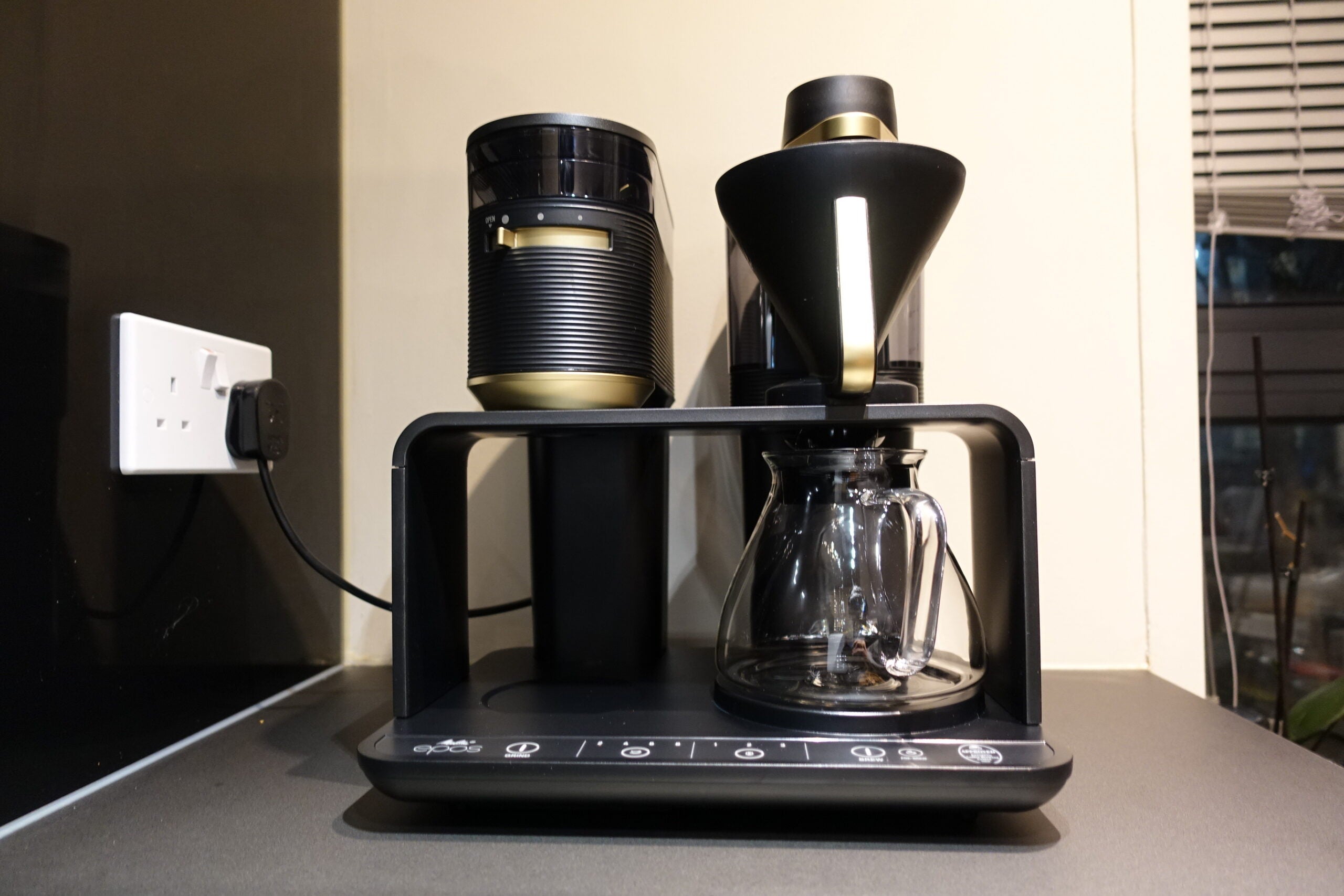
Gorgeous to look at and extremely powerful, the Melitta EPOS is an incredible bit of engineering and a brilliant filter machine for those that want the best quality coffee. The EPOS consists of two parts: the burr grinder on the left, which dispenses into the filter; and the automated pour-over that filters into the carafe.
Cleverly, the machine will grind the right amount of beans based on the number of cups you select to brew; however, you have to manually remember to fill the water to the right line manually, as the EPOS will empty the tank regardless of the setting you choose.
There’s a 1-litre water tank, which is a little small compared to many filter machines; however, what the EPOS lacks in quantity it makes up for in brew quality. There are three strength settings and a pre-brew option, letting you get the best out of any type of bean. The results were excellent, with the EPOS producing the best filter coffee of any machine that we’ve tested. If filter coffee is your drink of choice, this is the machine to get you the best-tasting coffee.
Coffee machine type: Filter, Size: 357 x 311 x 359mm, Milk frothing: No, Water tank size: 1-litre
Melitta AromaFresh Grind and Brew
A simple and effective filter machine
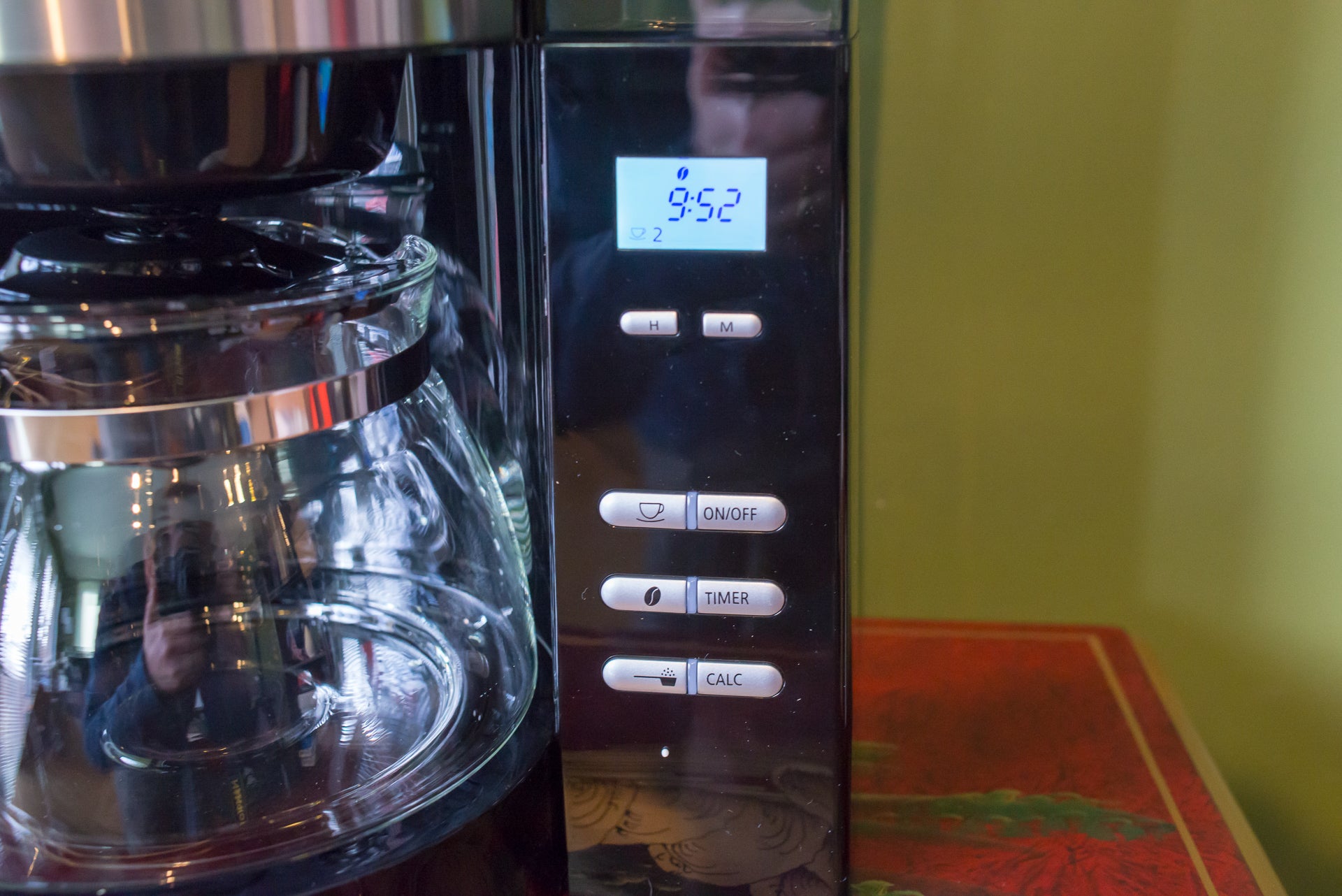
Filter coffee machines are best when used with freshly ground coffee, and the Melitta AromaFresh Grind and Brew makes that easy by including a grinder. While you can set the machine to deliver the right amount of coffee you need (two to 10 cups worth), you have to manually fill the right water level.
Melitta has used paper filters for the AromaFresh Grind and Brew, which is a great choice – you get a fresh one each time you make coffee. Washable filters may seem more convenient, but they can become tainted with use. Coffee quality is excellent, with the AromaFresh delivering rich and smooth coffee in large amounts.
There’s a handy timer, too, so you can set the machine to ensure your coffee is ready in the morning. For convenience and quality, the Melitta AromaFresh Grind and Brew is an excellent choice.
Coffee machine type: Filter, Size: 515 x 312 x 302mm, Milk frothing: No, Water tank size: 1.5-litre
Read our full Melitta AromaFresh Grind and Brew review
Nespresso Barista
A clever way to experiment with coffee
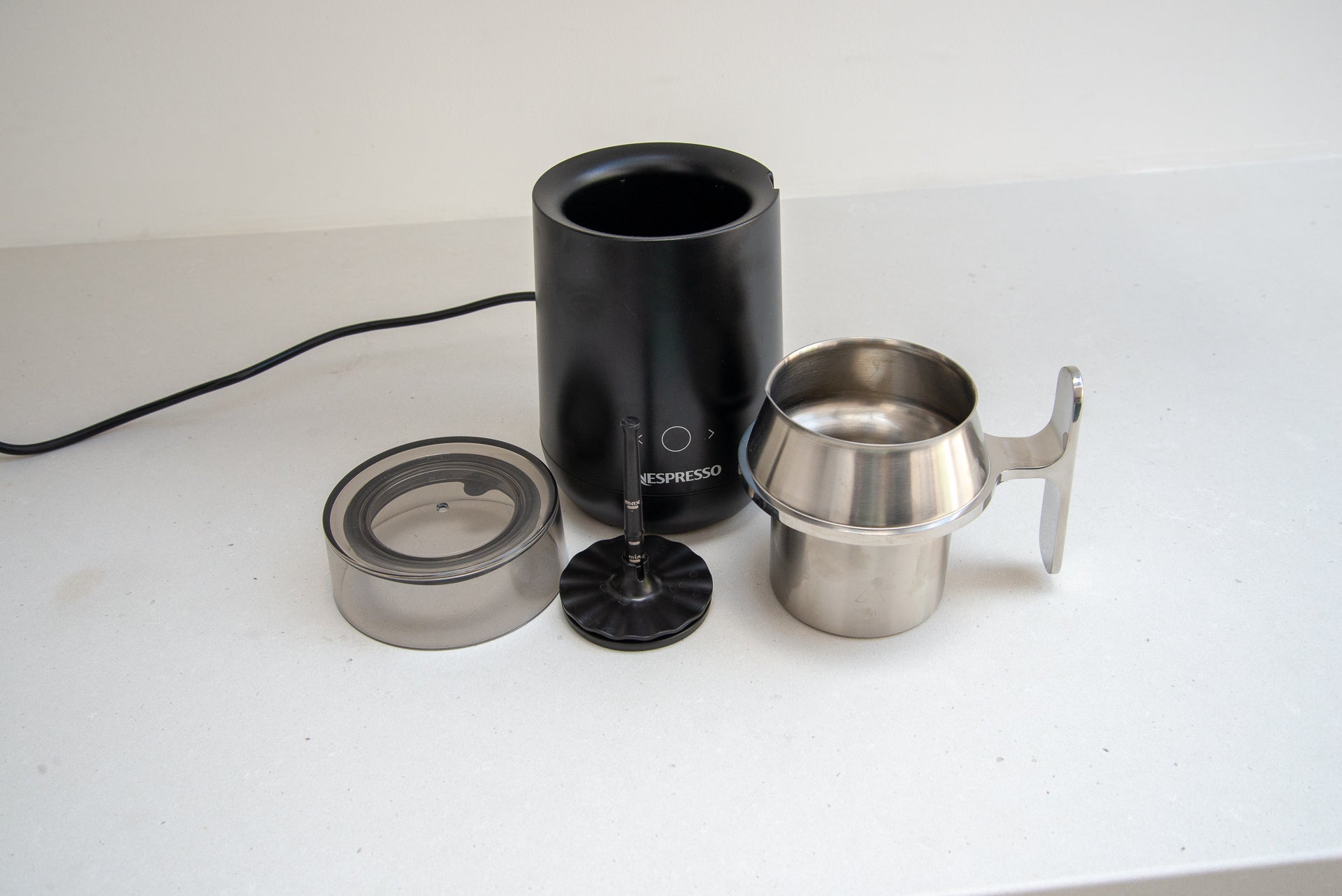
Not strictly a coffee machine in its own right, the Nespresso Barista is an add-on for all types of espresso machines, not just Nespresso ones. Use the touch-screen interface to select a recipe, add the ingredients, which mostly include a shot of espresso, and off you go.
The Barista then makes everything automatically for you, including delicious cold Iced Nitro espresso drinks, hot chocolate and even frothed milk. If you’re a little more adventurous, this is a great way to make some stunning drinks.
Coffee machine type: Accessory, Size: 154 x 125 x 125mm, Milk frothing: Yes (automatic hot and cold), Water tank size: N/A
Read our full Nespresso Barista review
What type of coffee machine should I buy? There are two main types of coffee machines. Filter coffee machines are the simplest, dripping hot water through ground coffee to create a large volume of drink. The resultant coffee tends to be smoother and, as you can keep a pot on the got, are great for large numbers of people or just for having coffee ready to go.
Espresso machines deliver coffee as a shot, distinctive thanks to the foamy head on top called the crema. Manual espresso machines use ground coffee (or beans you grind yourself) and require some skill to get working. They typically produce the best results, though. A bean-to-cup coffee machine does the hard work for you, griding and automatically pouring the coffee. Quality can be great, but you don’t quite get the results of a manual machine; the trade-off being that the job is much easier.
Pod or capsule machines are the easiest to use: drop in a pod and hit a button and you’re done. The downside is that the cost per cup is higher and you don’t get the same extensive range of coffees as with a machine that uses beans or ground coffee.
Should I use filtered water? Using filtered water can make your coffee taste better if you’re not a particular fan of the taste of your tap water. It’s worth trying if you’ve got a filter jug to see what difference it makes. More importantly, a water filter should be installed and used where possible in a coffee machine’s water reservoir, particularly if you live in a hard water area.
Using a water filter removes the impurities from your water, which can lead to better-tasting coffee. It also helps reduce limescale build-up, which will reduce problems with your coffee machine getting clogged up and requiring descaling. You’ll still need to regularly descale your machine (check it’s manual for the full details on how to do this), as a machine that has a lot of limescale in it will struggle to pour water at the right rate, and your coffee will be ruined.
Do I need a grinder? Coffee stays fresher for longer if it’s not ground. If you’re regularly using a manual espresso or filter machine, a grinder is a good addition. In particular, for a manual machine, using a coffee grinder lets you adjust the grind to suit your machine and coffee, further fine-tuning the results. The downside is that while you can use a cheaper grinder for a filter machine, you’ll need to spend a bit more to get a suitable grinder for a manual espresso machine: that’s particularly true if you have a more expensive coffee machine.
What milk options should I look for? If you have an espresso machine a way of making steamed milk opens up the potential to make a wide range of drinks from cappuccinos to lattes. A steamer wand is a traditional way of making frothy milk. You hold a jug under the wand, while steam adds air to the milk, swirling it around. A steamer wand gives you more control over the process, but the downside is that it can take quite a bit of skill to get the right results.
An automatic milk frother is a good alternative, producing steamed milk. These are typically available on bean-to-cup and pod machines. The simplest option is a system that steams milk and pours it, which is great for convenience, although the final results aren’t as good as pouring milk from a jug. Some machines can froth milk in a jug, or they use an external device, such as the Nespresso Aeroccino. You don’t quite get the results of doing the job yourself, but you can free pour your final drink to get the balance of espresso and milk that you want.
How many boilers do I need? If you buy a manual espresso machine, you can get single- or dual-boiler options. A dual-boiler coffee machine can produce espresso and steam milk at the same time. This cuts down on preparation time and lets you make milk drinks in the optimal time. They are a lot more expensive than single-boiler machines, where you first steam your milk, then reduce the temperature of the system to make a shot of espresso.
What type of pod machine is best? Nespresso capsules are the best by far. Nespresso is now available in two types. Original pods are designed to replicate the type of coffee that you get in a coffee shop. There’s a wide range of capsules available from Nespresso, although you can also choose from a growing range of third-party ‘compatible’ capsules. There’s a good reason to stick with Nespresso, though: it will recycle all of its capsules for free, either by organising a collection or by dropping old capsules into a Nespresso store.
There’s also the newer Nespresso Vertuo system, which uses large capsules. This system delivers larger mug-fulls of coffee and has a similar range of official capsules to the original system. Currently, there are no third-party options for Vertuo. All capsules are recyclable with Nespresso.
Nescafe Dolce Gusto machines are comparatively cheap, with a wide range of pods available in supermarkets. This system is a step up from instant coffee, but the reliance on powdered milk is a little disappointing.
Tassimo machines and pods are similar to Dolce Gusto, with a similar range of pod options available online or in good supermarkets. These use UHT milk capsules for some drinks.
What kind of maintenance is required?
All coffee machines require regular maintenance to keep them in the best working condition. The most important job you’ll do is descaling them, removing limescale from the innards to make sure that water flows smoothly through the machine. If you don’t descale your machine when prompted, you may find that the seize up, and water won’t pass through at the speed required to make decent coffee. Most coffee machines will warn you when it’s time to descale, based on the water hardness level that you set: the harder the water, the more often the job has to be done.
Espresso machines should also be cleaned with a cleaning tablet when prompted, which removes the oily residue from the beans. It helps keep your machine in the best working condition and ensures that you get the best taste.
If you have a steamer wand, this will need to be cleaned after every use. You can usually remove the tip to wash it in hot water to remove all milk residue. Make sure that you clean our drip trays (again, use some soapy water). For bean-to-cup machines, if they have a removable brew head, this should be removed and rinsed regularly, too.
